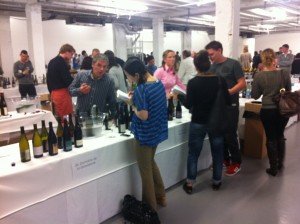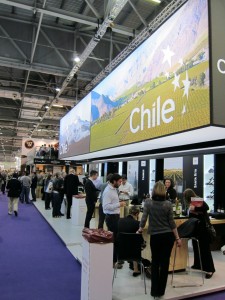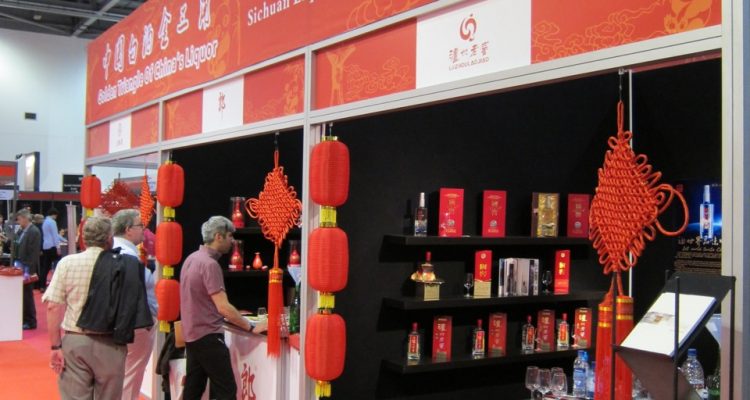Exploring the various parts of the wine world, from big brands to tiny artisanal producers, can be quite a study in contrasts. Shifting from the organic/biodynamic/natural wine fairs to the London International Wine Fair, yesterday, strongly illustrated those differences.

- The Real Wine Fair
The Real Wine Fair and RAW Fair were simply and democratically set events: tables with white tablecloths, the same for everyone. There was also something very informal about them, with a general sense of camaraderie seen, for example, when one vigneron would pour for his neighbor at the tables, when the neighbor went off for a break—or to taste some other colleagues’ wines.
Entering the London International Wine Fair, right after stepping out of those other, more relaxed events, felt like stepping into a different universe. In the vast hall at Excel, a trade show center in London’s Docklands, several miles East of the city center, the LIWF is a world of colorful, two-story high stands touting nations, big brands or large retail chains. There are hostesses in pink dresses serving Brazilian cocktails. There are lots of suits and ties—conspicuously absent from Real and RAW.
What sets you apart
In all of the fairs, people are there to sell wine and to make their products known. All these events are commercial operations: as a producer, national or regional wine board, retailer or other service provider, you pay for your space and hope to see your money back in eventual sales and greater awareness of your product.

- The huge Chilean stand at LIWF
In many ways, it’s the branding efforts that differ. Most of the producers at the natural wine fairs are small scale, they work on a one on one basis with eventual customers. Word of mouth, personal contacts—with eventual support from good reviews by wine writers—are the main channels. At LIWF, the push is on national or regional identities, the efforts in branding are more marketing-driven. You start thinking about categories and price points. Words like premium and super-premium are bandied about. It’s a different game.
The different ways of selling wine were explored in very interesting ways at an industry briefing on the marketing of wine brands moderated by Jamie Goode, where three industry experts tried to answer a difficult question: how can a wine stand out from the crowd? Dan Jago, category director at Tesco, the supermarket chain that is also the largest retailer of wine in the United Kingdom, pointed out that in the wine world, a major difficulty is what he called “infinite substitution.” “There is always another product that will do the trick, in any shop. And if you do anything new, there are 45 others that will jump in and do the same thing,” he summed up, pointing out how most customers in supermarkets or large wine stores pick bottles rapidly, to get a price point and taste profile.
Jeff Slater, Global Director of Marketing at Nomacorc, the company that organized the briefing, pointed out that there are something like 700 different wines in an average US supermarket, while there might be 60 breakfast cereals. “I can’t think of any other product category that has anything near that number of products in a store.” For him, this creates a “big fat middle,” where most products are good, but not unique, and in many ways interchangeable.
What can catch the customer’s attention may be a simple thing: Slater presented an anecdote he wrote about on his personal blog, pointing out that his mother regularly buys him a Gattinara wine that he likes, simply because the shape of the bottle is different. “It’s the only one I can remember,” she told him.
 The story may be a healthy reminder for winemakers who want to promote the uniqueness of their terroir and the qualities of a particular vintage. Most buyers don’t really care that much. As Jamie Goode said, “We live in a bubble, in the wine world, sometimes. The discussions we have make perfect sense to us, but they would seem very odd and hard to understand for most others.” That may just be the nature of the beast, however, as wine really shines through its diversity and complexity—at least, for those who are interested in such details. And that may explain why “no one has come up with the ultimate global wine brand,” as Dan Jago mused. (Thankfully, one might be tempted to add.)
The story may be a healthy reminder for winemakers who want to promote the uniqueness of their terroir and the qualities of a particular vintage. Most buyers don’t really care that much. As Jamie Goode said, “We live in a bubble, in the wine world, sometimes. The discussions we have make perfect sense to us, but they would seem very odd and hard to understand for most others.” That may just be the nature of the beast, however, as wine really shines through its diversity and complexity—at least, for those who are interested in such details. And that may explain why “no one has come up with the ultimate global wine brand,” as Dan Jago mused. (Thankfully, one might be tempted to add.)
Creating “flavour spaces”
So how does one stand out—or even just carve one’s own space—in such a crowded field? There were some ideas about being truly committed to your products and communicating that, or about community building through social media. The panelists also pointed to the world of craft beer and how it has carved out “a new flavour space” that allowed producers in that category to define themselves more clearly and set themselves apart better.
There have been—and are—moments like that in the wine world, of course. Australian Shiraz certainly carved out such a space twenty years ago or so, and so did New Zealand Sauvignon Blanc, pulling individual producers along as consumers looked to these well-defined category profiles. The organic/biodynamic/natural wine world also has had such moments, with a trend towards carbonic maceration in red wines, inspired by Beaujolais and applied in many other regions. This year, the same seems to apply to orange wines (white wines vinified with prolonged skin contact, giving them deeper color, tannins and a very different profile).
There were a lot of orange wines at the RAW and Real wine fairs, from all parts of the world. Certainly a lot more than a few years ago. Strangely enough, the emergence of that new “flavour space” also pointed out to the principle of “infinite substitution.” It seems like the natural wine world, even though it prides itself for the individuality of wines, may not be totally immune to people jumping on bandwagons.
[author] [author_image timthumb=’on’]http://palatepress.com/wp-content/uploads/2009/12/remyPPress.jpg[/author_image] [author_info]Rémy Charest is a Quebec City based journalist, writer, and translator. He has been writing about wine and food for over 12 years in various magazines and newspapers. He writes two wine blogs (The Wine Case, in English, and À chacun sa bouteille, in French) and, as if he didn’t have enough things to do, he also started a food blog in English, The Food Case, and one in French, À chacun sa fourchette.[/author_info] [/author]

